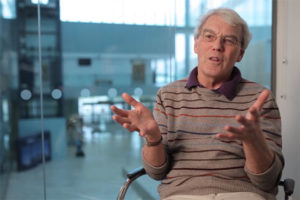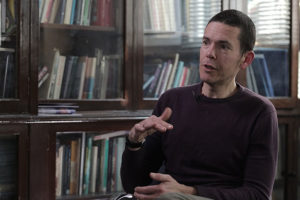Perception of Music
Neuroscientist Diana Omigie on tuning systems in different cultures, congenital amusia and aspects that influe...
The video is a part of the project British Scientists produced in collaboration between Serious Science and the British Council.
Cell membranes are very important, they’ve been around for about 4 billion years, since the very first cells on Earth were developed, at the early stages of the evolution of life. The cells became more important, but the key characteristic of cells is that they’re surrounded by an envelope that seals them from the outside world. So the key function of the cell membrane is to separate the inside of the cell, which is controlled by life processes, from the outside of the cell, which is the environment. And then through time different functions of the cell membrane have evolved to give to cell the ability to cope in the big world.
So for many years it wasn’t known what the cell membrane was made of other than that it’s a barrier between the inside and the outside of the cell. But about… probably about a hundred years ago from now originally Gorter and Grendal studied the red blood cell in the human body and extracted from the cell the fats, the lipids that are now known to be one component of the membrane. And they showed that there are enough lipid molecules in the membrane of a cell to make two complete layers covering the cell, and that was the origin of what was the original lipid bilayer theory of the cell, which is that it’s made up with largely lipid molecules which have a hydrophobic (that means “a water-repelling”) end to them and then a hydrophilic (a “water-loving”) end, so the hydrophobic is fat, and the hydrophilic is sugars and phosphates and things like that. So you have this molecule, the lipid, that has a hydrophobic and a hydrophilic end, and they pair together to form a bilayer. A lipid bilayer surrounds the cell. And for quite a while that was mostly what was known about the cell membrane.
And then, mid 70’s to mid 80’s, people started to study the proteins and how they are incorporated into the membrane. And our work, that’s work that I did with Nigel Unwin back in 1975, we determined the very first low-resolution structure of the membrane protein called bacteriorhodopsin and then, about ten years later, there was another membrane protein structure, the reaction centers from bacteria or green plants which absorb light and convert that light energy into other forms of cellular energy. And so with those two membrane protein structures you had a real image of the protein structure with the polypeptide chain, proteins are made up of a polypeptide, the polypeptide crosses the membrane back and forward in the form of a helical structure, that’s the α-helixes that Linus Pauling had hypothesized back in 1950 and that had been found in the myoglobin – the very first protein structure, but not in the membrane.
So now we’ve gone from knowing the structures of some nonmembrane proteins to now knowing the structure of the first two membrane protein structures. And then with time our understanding of the nature of the cell membrane has become more detailed, and so now we know, for example, that the lipid molecules (which before were just a generic class), we know partly from Mark Bretscher’s work, but partly from subsequent work that all the glycolipids (that means these fatty hydrophilic/hydrophobic molecules that have a sugar molecule on it; “glycolipid” means having a sugar molecule), those lipids are all on the outside facing the outside world, and then on the inside you have acidic or zwitterionic (that means they have two charges, positive or negative) facing the inside. And then similarly there are now known thousands of membrane [components], each one of them has a different structure and the membrane proteins have a different function, so there are multiple different functions in the membrane, each one catalyzed or activated as by a little molecular machine which is either the protein molecule or complex of protein molecules.
So all of the multiple functions of the membrane sensing the outside world are transporting small molecules inside or outside the membrane or signaling to the outside world. Each one of the functions of the proteins in the membrane, which help the cell to communicate and interact with the outside world, they are performed by all these different protein molecules.
And then with time as life evolved from single-celled organisms up through higher eukaryotes, many different types of specialized membrane evolved under Darwinian natural selection evolution and in a normal cell, for example, in a human or in an other eukaryotic organism, there are many different types of membranes that characterize the different substructures in the cell, for example, there is the nucleus, it has a membrane, the nuclear membrane; there are the mitochondria which are the energy center of the cell, they produce ATP, they have two different membranes, and in fact it’s thought that mitochondria and chloroplasts, two subcellular organelles, it’s thought that they are both derived from the capture of an early type of bacteria by other single-celled organisms, so you have the so-called endosymbiont theory and everybody believes this now. So that’s two of the organelles, but there’s also the endoplasmic reticulum, where molecules are synthesized on ribosomes and are secreted, or put in the membrane, or put into the cytoplasm, and then through the Golgi apparatus through lysosomes they are secreted to the outside world. So now you have a much richer understanding of how cell membranes work based on the specific proteins that are put there under genetic control from the DNA and allow the cell to have its normal function and interact with the outside world. That’s a reasonably good overview of cell membranes.
One interesting question is – what is the difference between the membranes that surround cells, which would be a single membrane, and the membranes that form the compartments within cells. And there are probably ten or a dozen well-characterized different types of membranes, and of course, each one of them could be the topic of another lecture, but let me just give a brief summary of them.
And then in eukaryotic cells, you have a nucleus containing all the DNA. The nuclear membrane separates nucleus from the cytoplasm, so the DNA is transcribed into RNA that goes out into the cytoplasm, translated by a ribosome into proteins that are either secreted into the cytoplasm or through the endoplasmic reticulum (sort of another membrane structure that’s in the cytoplasm), and in the endoplasmic reticulum in eukaryotic cells the proteins are either put into the membrane or secreted through into the interior of the endoplasmic reticulum and there via the Golgi and various vesicles they eventually end up outside the cell. So there’s a secretion pathway that is organized by a series of different membranes and in each and all of these different membranes you have different proteins that give each of the membranes their character.
And what is not known, and this is one of the future secrets that a young scientists wishing to win a Nobel Prize might like to aim for, we do not know quite what it is that makes the Golgi apparatus into the Golgi, the endoplasmic reticulum into the endoplasmic reticulum, but it’s a self-organizing system for which there is a missing theory that a lot of the cell biologists, neurobiologists in this laboratory, as well as in other parts of the world, are quite interested in trying to understand. In the area of cell membranes, this is probably the one big problem that is not solved: exactly what is it in each cell that gives each type of membrane its particular characteristic. Obviously, once it’s constructed, it’s synthesized, we know how it works, we know the proteins in them, but what it is that controls how is it that the endoplasmic reticulum remains endoplasmic reticulum, how does the cell membrane remains [the cell membrane], how does the Golgi remains [the Golgi apparatus]… That is an unsolved problem, and so that’s something for the future.

Neuroscientist Diana Omigie on tuning systems in different cultures, congenital amusia and aspects that influe...

Molecular Biologist Richard Henderson on new protein structures, experiments with electron cryomicroscopy, and...

Geographer Mathias Disney on the chemistry of photosynthesis and why we depend on it